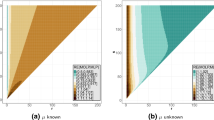Summary
The occurrence of future record values based on data from a sequence of independent, identically distributed random variables is considered. Two situations are analysed, namely (i) where only the firstm record observations have been noted, and (ii) where all the observations have been noted up to themth, record. Tolerance regions and Bayesian predictive distributions are derived for the increase in size of the (m+r)th record value over the observedmth record value for two exponential models. Predictive distributions are also given for the additional number of observations required after themth record value until the (m+1)th record value occurs.
Similar content being viewed by others
References
Abramowitz, M. and Stegun, I. (1972).Handbook of Mathematical Functions, Dover, New York.
Ahsanullah, M. (1978). Record values and the exponential distribution,Ann. Inst. Statist. Math.,30, 429–433.
Ahsanullah, M. (1980). Linear prediction of record values for the two parameter exponential distribution,Ann. Inst. Statist. Math.,32, 363–368.
Aitchison, J. and Dunsmore, I. R. (1975).Statistical Prediction Analysis, Cambridge University Press, Cambridge.
Chandler, K. N. (1952). The distribution and frequency of record values,J. R. Statist. Soc., B.14, 220–228.
Foster, F. C. and Stuart, A. (1954). Distribution-free tests in time-series based on the breaking of records.J. R. Statist. Soc., B,16, 1–22.
Galambos, J. (1978).The Asymptotic Theory of Extreme Order Statistics, Wiley, New York.
Renyi, A. (1962). Théorie des éléments saillants d'une suite d'observations,Colloq. Combinatorial Meth. Prob. Theory, Aarhus University, 104–115.
Resnick, S. I. (1973a). Limit, laws for record values,J. Stochastic Processes and their Appl. 1, 67–82.
Resnick, S. I. (1973b). Record values and maxima,Ann. Prob.,1, 650–662.
Shorrock, R. W. (1972a). A limit theorem for inter-record times,J. Appl. Prob.,9, 219–223.
Shorrock, R. W. (1972b). On record values and record times,J. Appl Prob.,9, 316–326.
Tata, M. N. (1969). On outstanding values in a sequence of random variables,Zeit. Wahrscheinlichkeitsth.,12, 9–20.
Author information
Authors and Affiliations
About this article
Cite this article
Dunsmore, I.R. The future occurrence of records. Ann Inst Stat Math 35, 267–277 (1983). https://doi.org/10.1007/BF02480982
Received:
Revised:
Published:
Issue Date:
DOI: https://doi.org/10.1007/BF02480982




